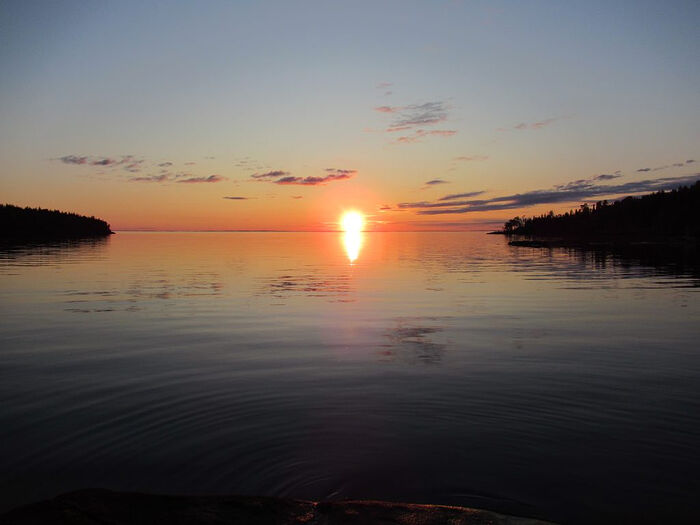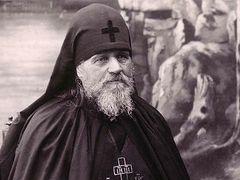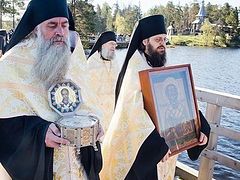White nights. The sun has turned red and made ready to dip into Lake Ladoga, to rest from the labors of the past day. Dong!.. The silence is broken by the church bells inviting the tour guides to the night Liturgy. This is the schedule that’s formed itself—Sunday is a tense work day for those working in the Pilgrimage Service of the Holy Transfiguration-Valaam Monastery, and so the Liturgy was instituted specially for them in the Resurrection Skete on Saturday nights–Sunday mornings, so that they would have a chance to pray.
When after the destruction of the soviet period Valaam Monastery was reborn and began receiving crowds of pilgrims and tourists, the Resurrection Skete became the summer habitation of tour guides, while the monks resettled further away from the tourists and closer to the monastery. And so to the sound of the festal bell-ringing, the doors of the skete buildings are thrown open and the tour guides rush to church.
The Resurrection Church is two-storied; the lower church, austere and dusky, reminds one of the sufferings of our Lord Jesus Christ, and has a replica of the Lord’s Sepulcher, while the upper church, to the contrary, is grand and joyful. It announces to all the main event in Church history—the Resurrection of Christ. It is in this church that the Paschal troparion is sung throughout the year, and here everything is ready for celebrating the Liturgy.
The church quickly fills with tour guides.
“Blessed is our God, always, now and ever, and unto the ages of ages,” the priest’s voices rings out.
“Amen. Glory to Thee our God, glory to Thee,” is heard in reply.
The acoustics in the church are remarkable. In the late twentieth century, a dance and concert hall were set up here, during the time that the “Valaam” tour base was active in this spot. The church’s interior was completely lost, but it was restored in our times. The icons in the unusual and festive porcelain iconostasis tell of the crucifixion, death, burial, and Resurrection of the Savior.
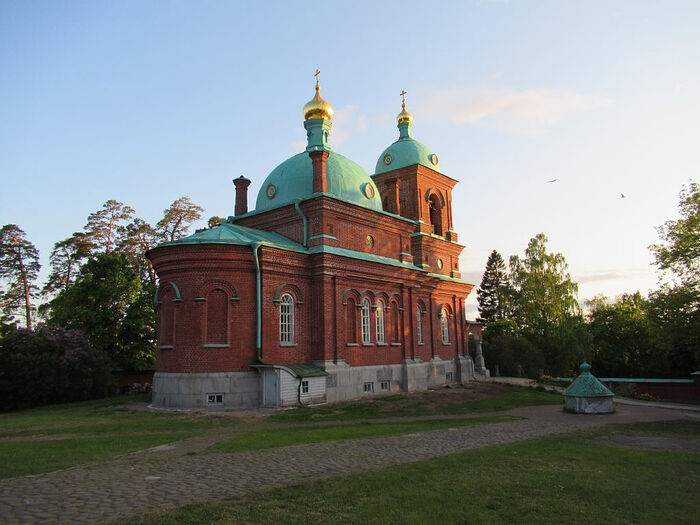 Church of the Resurrection of Christ
Church of the Resurrection of Christ
The sun finally disappears completely into Lake Ladoga, and all nature on the Valaam archipelago is immersed in the dark of night, so that it can rest before the coming day. But in the Church of the Resurrection of Christ, prayer goes on. Now the hieromonk pronounces the dismissal, and the tour guides come one-by-one to kiss the cross. The hands of the clock show two a.m. The sun is already turning pink in the east. In a few hours our work day begins, but for now we'll doze a little.
Today is the feast of All Saints. The lucky few who have been given the day off are gathering in the central house in order to participate in the solemn cross procession to the All Saints Skete, the most ancient of all the sketes founded on Valaam. Today is its patronal feast and the only day of the year when women and girls are allowed in. Today the doors of the skete will be open all day for anyone who wishes to enter, and late in the evening they will again be closed till next year.
But I will not be able to go with the cross procession, because I am standing on the dock to meet the tourists. Who are these people? Why are they coming to Valaam? The tour guides don’t know the answer to this question. Every day there are new faces, new destinies. Some come to pray, others just to stroll around, while others come as company to someone else… Some of them sincerely believe in God, others are only beginning to believe, while others still have their doubts. But we, the tour guides, will never know about this.
Now a group of people who have been on a long cruise over the rivers and canals from Moscow to northern Russia are standing before me with eyes wide open, photographing the shores of the Monastery harbor and sighing, “It’s so beautiful here!” It’s time for me to begin the tour and try my best, so that these people’s visit to Valaam might linger in their memories as something that warms them during throughout the years of their lives.
Having passed through the central and main building, and having listened to a concert by the monastery’s festal choir, we enter the very heart of Valaam—the main cathedral, where the relics of the monastery’s founders, Sts. Sergius and Herman, rest underground. Who were these men? What do we know about them? Almost nothing. Their Lives were not preserved. But in the Tales of Bygone Years is written only that they came from eastern countries (Byzantium). Now for more than several hundred years people come to the monastery they founded, pray, and ask for their aid. And if they hadn’t received it, then most likely their names would have been long forgotten. But “a sacred place is never empty”.
Here in the lower church of the cathedral are the relics of St. Antipas of Valaam, a monk of that same All Saints Skete that is celebrating its patronal feast today. I tell the tourists about St. Antipas. The elderly ladies, or more precisely lady retirees with fashionable hairstyles and died gray hair under bright scarves, sigh, “Ah! Today that skete is open, but we are sailing on!” But then they receive a gift from St. Anitpas: When we come to the reliquary we see that it’s open and we can venerate the relics themselves. The saints were as if saying, “If you want you can come to me, and I’m ready to pray to God for you and help you, if it be God’s will.” No longer listening to me, the women go to venerate the relics.
 Holy Transfiguration Cathedral The tourists return to the dock joyful. They mill around on the shore and talk with each other about how good it would be to come here again, not for a few hours but for several days. I say goodbye to the tourists and run to lunch. I only have one tour group today, so my work day is done.
Holy Transfiguration Cathedral The tourists return to the dock joyful. They mill around on the shore and talk with each other about how good it would be to come here again, not for a few hours but for several days. I say goodbye to the tourists and run to lunch. I only have one tour group today, so my work day is done.
In the trapeza of the Resurrection Skete the tour guides are abuzz—after lunch (we don’t know exactly what time) a monastery automobile will come and take anyone who wants to go to the All Saints Skete. All those interested must write down their names on a list. There are many of us, and although the automobile is large it can only hold so many.
My friends and I are not looking for an easy path and decide to go on foot. “It’s only ten kilometers to All Saints Skete, and two more to Smolensk Skete. The main thing is to not be late for dinner.”
We begin our way along the main monastery road, built by the monks in the eighteenth century, photographing the flowers and rejoicing in the sunny day. It’s wonderful weather today! Almost no wind, and warm. We didn’t even take off our jackets. Right near the All Saints skete an old woman, a monastery laborer, passes us by. This is a true old woman—wearing a long, dark skirt, with gray hair under a white headscarf, and a crutch in each hand.
“Girls, are you headed for the skete? Oh, what grace there is there! I went on the cross procession this morning, prayed at the Liturgy, and now I’m going there again. After all, the skete is only open once a year! Only once a year do they let the sisters in. Well, I won’t hold you up,” said the old lady as she passed us by and quickly moved ahead, leaning on her crutches.
“It’s not you holding us up… It’s we who can’t catch up with you,” one of us said thoughtfully, expressing our common opinion.
In the skete we were met by the tour guides who had come by automobile.
“Quick, go up the bell tower! They’ve blessed all the tour guides to ring the bells!”
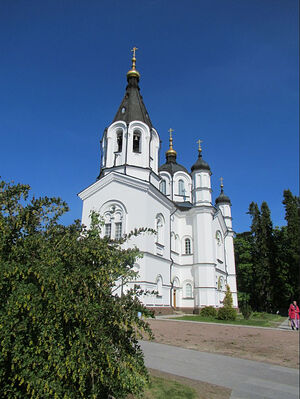 Church of the Skete of All Saints Quickly! Up the stone staircase to the heavens, to the bells! Filling the vast spaces of Valaam with the joyful ringing, the tour guides were in no hurry to descend, but wrapped in their jackets and hoods they happily smiled, standing under the bells in the cold, penetrating wind. Down below it was warm and calm, but on the bell tower a strong wind was whining, reminding us that we are on an archipelago in the northern part of Lake Ladoga.
Church of the Skete of All Saints Quickly! Up the stone staircase to the heavens, to the bells! Filling the vast spaces of Valaam with the joyful ringing, the tour guides were in no hurry to descend, but wrapped in their jackets and hoods they happily smiled, standing under the bells in the cold, penetrating wind. Down below it was warm and calm, but on the bell tower a strong wind was whining, reminding us that we are on an archipelago in the northern part of Lake Ladoga.
We had climbed up at the very moment that the elderly laborer who had passed us on the road had cast her crutches aside and was happily ringing the bells with all her might.
Finally it was my turn. Taking up the ropes, I asked the bell ringer with surprise, “How do I do it?”
“Like this.”
And it all became wonderful and understandable. I wanted to tell the whole world, “People! It’s a feast day today! It’s Sunday! Rejoice!” I and the bell ringer rang the bells and announced to all that it’s the patronal feast of All Saint’s Skete.
The tour guides each took their turns, the ringing of the bells poured across the skete, the whole archipelago and over Lake Ladoga. My friends and I had already gone into the church to pray and again climbed back up, while the bells rang and rang…
“Interesting, don’t the monks’ ears hurt? We’ve been banging the bells over their heads all this time,” I whispered to my friend, and just then saw I a monk climbing up the bell tower.
“That’s it, brother, let’s stop,” he said to the bell ringer.
The bells obediently fell silent. The elderly worker-woman tried to protest:
“Can I, just one more time?”
“Amen,” the monk repeated and started descended the stairs.
“Without a blessing, I can’t,” the bell ringer threw up his arms.
We started descending from the bell tower. And now in total silence we again entered the church, where normally only monks pray.
 Having left the walls of the All Saints Skete, we headed for the Smolensk Skete, which was founded during the First World War and in which prayers are made for fallen soldiers. These two sketes are joined by a quiet forest road. It’s an amazing picture—you walk and walk through the woods, trees all around, and suddenly the branches brush aside and before you opens the sight of an austere, snow-white church, with a cupola reminiscent of an ancient Russian warrior’s helmet. Peace and quiet. There is no throng of tourists here. It even seems that there is no one here at all. The brothers’ quarters are located some distance apart, and therefore we don’t see them. Only the church, the pines, Lake Ladoga, and prayer.
Having left the walls of the All Saints Skete, we headed for the Smolensk Skete, which was founded during the First World War and in which prayers are made for fallen soldiers. These two sketes are joined by a quiet forest road. It’s an amazing picture—you walk and walk through the woods, trees all around, and suddenly the branches brush aside and before you opens the sight of an austere, snow-white church, with a cupola reminiscent of an ancient Russian warrior’s helmet. Peace and quiet. There is no throng of tourists here. It even seems that there is no one here at all. The brothers’ quarters are located some distance apart, and therefore we don’t see them. Only the church, the pines, Lake Ladoga, and prayer.
The day is inclining towards evening. The road back to the Resurrection Skete awaits us, then dinner in the common trapeza, at which the organizer will tell us about tomorrow’s work day. Afterwards we’ll eat up the modest remains of our non-fasting foods, because tomorrow the Apostles Fast begins. Then the sun will turn red and get ready for its brief dip into the Ladoga, to give nature, and us, a rest before the new day.

